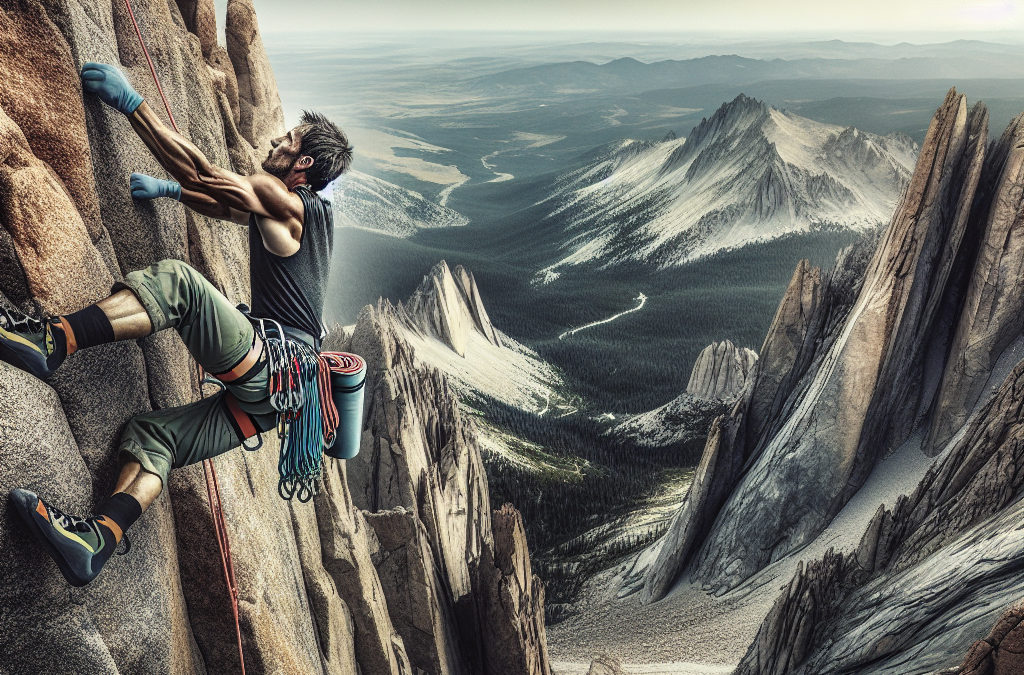If you are an adrenaline junkie, nature enthusiast, or simply seeking a new adventure, “The Ultimate Guide to Planning an Outdoor Climbing Trip” could be your best ally. Within its content, you will discover all the essentials you need to consider, from gear selection to site navigation for a viable, unforgettable and above all, safe climbing experience. It’s like having a personal climbing mentor at your fingertips, guiding you step-by-step through the rewarding journey of planning your very own outdoor climbing adventure. Let’s get ready to embrace the great heights!

Understanding The Basics of Outdoor Climbing
Climbing is a bracing activity that is physically demanding, mentally taxing yet incredibly rewarding at the same time. It’s a fantastic way to connect with nature and nourish your adventurous spirit. If you’ve been considering moving beyond the indoor climbing walls to conquer the real rock faces outdoors, here’s a guide to help you understand the basics of outdoor climbing.
Differentiating Between Indoor and Outdoor Climbing
The first thing you need to understand is how outdoor climbing differs from its indoor counterpart. Indoor climbing takes place within a controlled environment, on artificial walls embedded with holds. The routes are pre-set and graded for difficulty. Outdoor climbing, on the other hand, is in the wilderness. The walls are natural rock faces, and the routes are determined by the features of the rock. It is less predictable and more challenging but offers a more authentic experience.
The Challenges and Rewards of Outdoor Climbing
Outdoor climbing presents several challenges. The unpredictability of nature, the weather, and the quality of the rock are just a few factors that make outdoor climbing tougher and riskier. However, with these challenges comes the reward of a thrilling adventure, a profound connection with nature, and a remarkable sense of achievement.
Key Climbing Terms You Should Know
Before you embark on your outdoor climbing journey, it’s essential to familiarize yourself with some key climbing terms. Belaying refers to a technique where a climber is secured with a rope. A climber ‘on belay’ is safeguarded from a fall. Leading refers to the first person to climb a route, while the one following is said to be seconding or following. A pitch is a section of a climb between two belay points, while a crux is the most difficult section of a route. These terms would help you communicate effectively with other climbers.
Choosing Your Outdoor Climbing Destination
The choice of your climbing destination is crucial as it sets the tone for your entire adventure. It’s important to choose a location that is aligned with your climbing abilities and preferences.
Factors to Consider When Choosing Your Climbing Destination
When choosing a climbing destination, you need to consider several factors. These include your level of climbing expertise, the type of climbing you prefer (trad, sport, bouldering, etc.), the climbing grades you’re comfortable with, access to professional guides if needed, and the overall appeal of the location.
Popular Outdoor Climbing Destinations Around the World
Some popular climbing destinations around the world include Yosemite National Park in California, the French Alps, and the Dolomites in Italy. Each of these destinations offers a distinct climbing experience, varied routes, and remarkable scenery.
Understanding the Route Grades at Your Chosen Destination
Grading scales for climbing routes vary depending on the country and perhaps even the specific climbing area. They provide an estimate of the difficulty level of a climb. It’s essential to understand the grading system at your chosen destination to select suitable climbs and avoid accidents risk.
Essential Gear for Outdoor Climbing
The right climbing gear is indispensable to ensure safety and enhance your climbing experience.
Checklist of Basic Outdoor Climbing Equipment
A basic outdoor climbing gear checklist includes a climbing helmet, a harness, a belay device, carabiners, climbing ropes, quickdraws for sport climbs, cams and nuts for trad climbs, and of course, climbing shoes. Don’t forget to pack chalk for improving grip and a chalk bag to carry it.
How to Choose Your Climbing Shoes and Helmet
Climbing shoes should be comfortable yet snug and provide excellent grip. Flat shoes are ideal for beginners while those with a downturned shape are suited to more advanced climbers. Climbing helmets should be lightweight, adjustable and comfortable to wear. They should provide ample ventilation and include clips for a headlamp.
Proper Care and Maintenance of Your Climbing Gear
Proper care and maintenance of your gear is crucial to ensure its longevity and effectiveness. Avoid exposing gear to extreme temperatures or chemicals, store it in a cool, dry place, inspect it regularly for any signs of wear or damage, and clean it as per the manufacturer’s instructions.
Understanding Weather and Climbing Seasons
Weather and season significantly influence the feasibility and safety of an outdoor climb.
Typical Climbing Seasons for Different Regions
Climbing seasons differ across various regions. While spring and fall usually offer ideal climbing conditions in most areas, some locations might be best suited for winter or summer climbing. It’s crucial to research and plan your trip accordingly.
The Impact of Weather Conditions on Climbing
Weather conditions can profoundly affect climbing. Rain can make the routes slippery, wind can make climbing more challenging, and unexpected changes in weather can suddenly increase the risk factor. Always check the weather forecast before your climb and be prepared to adjust your plans if necessary.
Resources for Weather Forecasts and Climbing Conditions
Several online resources provide weather forecasts and information about climbing conditions. Websites like Mountain Forecast and Meteoblue offer detailed weather forecasts for specific altitudes on mountains worldwide.

Preparation and Training for Outdoor Climbing
Beyond choosing the ideal location and the necessary gear, preparing and training for the climb itself is crucial.
Physical Fitness Requirements for Climbing
Climbing demands a high level of physical fitness. It requires strength, particularly in your upper body and core, stamina, flexibility, and good balance. Regular fitness training, such as strength workouts, cardio exercises, and climbing-specific workouts, can help improve these aspects.
Indoor Climbing Training for Outdoor Climbing
Indoor climbing is a great way to prepare for outdoor climbing. It helps develop climbing technique, strength and stamina, and gives an understanding of gear and safety protocols. Most climbing gyms offer different types of climbs that mimic various outdoor climbing scenarios.
Mental Preparation for Outdoor Climbing
Outdoor climbing is as much a mental challenge as it is a physical one. Developing mental toughness, building confidence, conquering fears, and learning to handle pressure and uncertainties calmly, are all essential for a successful climb.
Understanding Climbing Etiquette and Protocols
Just as in any sport or outdoor activity, there are certain etiquettes and protocols in climbing that ensure the safety and enjoyment of everyone involved.
General Climbing Etiquette
Following general climbing etiquette means respecting fellow climbers, keeping noise levels down, not monopolizing popular routes, and being patient and considerate. It also means leaving no trace by cleaning up after yourself and not damaging the natural environment.
Safety Protocols When Climbing
Observing safety protocols is critical in climbing. Always double-check your gear, knots, and safety systems. Follow the climber-belay team principle, where one person climbs while the other belays, and communication between the two is continuous and clear.
Environmental Considerations in Outdoor Climbing
Climbers should respect and protect the natural environment. Stick to established trails, avoid trampling vegetation, do not disturb wildlife, and make sure any waste is carried out.
Planning Your Climbing Itinerary
A well-planned itinerary ensures a smooth and enjoyable climbing trip.
Determining the Duration of Your Climbing Trip
The duration of your climbing trip depends on various factors such as your fitness levels, the difficulty of the routes you plan to climb, and how many routes you want to attempt. Considering these factors can help you decide the trip duration, including travel days, climbing days, and rest days.
Balancing Climbing Days with Rest Days
Climbing is immensely taxing on the body, and rest days are necessary for recovery. Plan your itinerary such that you have a suitable number of rest days. A popular strategy is to follow a cycle of two or three climbing days followed by a rest day.
Incorporating Other Activities into Your Itinerary
Outdoor climbing trips can also include other activities like hiking, sightseeing, or visiting local attractions. Including these can enrich your travel experience and give your body a break from the rigorous climbing schedule.
Nutrition and Hydration for Climbers
Proper nutrition and hydration play key roles in a climber’s performance and recovery.
Basic Nutrition Tips for Climbing
A balanced diet, rich in carbohydrates, protein, and healthy fats is vital for climbers. Carbohydrates provide energy for the climb, protein aids recovery and muscle growth, and fats are a dense source of energy.
Staying Hydrated During Your Climbing Trip
Maintaining proper hydration is central to a climber’s performance, particularly in high-altitude and hot climates. Always carry adequate water, and remember to drink regularly, even if you’re not feeling thirsty.
Ideal Foods to Pack for a Climbing Trip
When packing food for a climbing trip, choose food that is dense in nutrients, lightweight and easy to pack. Trail mix, energy bars, dried fruits, and jerky are popular choices. For meals, instant oats, dehydrated meals and ready-to-eat pouches can be handy.
First Aid and Safety Measures for Climbing
Safety is paramount in climbing and being prepared for emergencies is a must.
Components of a Climbing First Aid Kit
A climbing first aid kit should include essential items like bandages, antiseptic wipes, blister treatments, tweezers, safety pins, pain relievers, and a CPR mask. Some climbers also carry a splint and a heat-retaining blanket in case of severe emergencies.
Learning Basic First Aid Skills
All climbers should have basic first aid skills. Knowing how to respond to common injuries like cuts, abrasions, sprains, and fractures can make a significant difference in an emergency. It’s worthwhile to invest in a first aid course designed specifically for outdoor adventurers.
Emergency Procedures for Climbing Accidents
In case of an accident, the first step is to ensure the injured person’s immediate safety. Administer first aid as required, and get professional medical help as soon as possible. It’s essential always to carry a means of communication like a cell phone or a radio.
Post-Climbing Recovery and Care
Climbing pushes your body to its limits. Hence, post-climb recovery and care are essential to help your body restore and prepare for your next climbing adventure.
Importance of Proper Post-Climbing Recovery
Post-climbing recovery involves replenishing your body’s energy stores, repairing muscle tissue, and allowing your body to adapt to the physical stress. Appropriate nutrition, adequate rest, and hydration are essential components of recovery.
Common Climbing-Related Injuries and How to Treat Them
Common climbing-related injuries include overuse injuries like tendonitis and climbing-specific ones like pulley injuries or climber’s elbow. Most minor injuries can be treated with rest, ice, compression, and elevation. However, any significant pain or injury should be evaluated by a medical professional.
Getting Back to Climbing After an Injury
Returning to climbing after an injury should be gradual and guided by a health professional. Start with light, non-impact activities before getting back to climbing. And when you do return, start with easy climbs before slowly progressing to your pre-injury level. Listen to your body and be patient with your recovery.
In all, planning an outdoor climbing trip involves careful preparation, the right gear, training, and above all, respect for the mountains and the thrill they provide. Remember, the journey is every bit as rewarding as reaching the summit. Stay safe and enjoy the climb!

